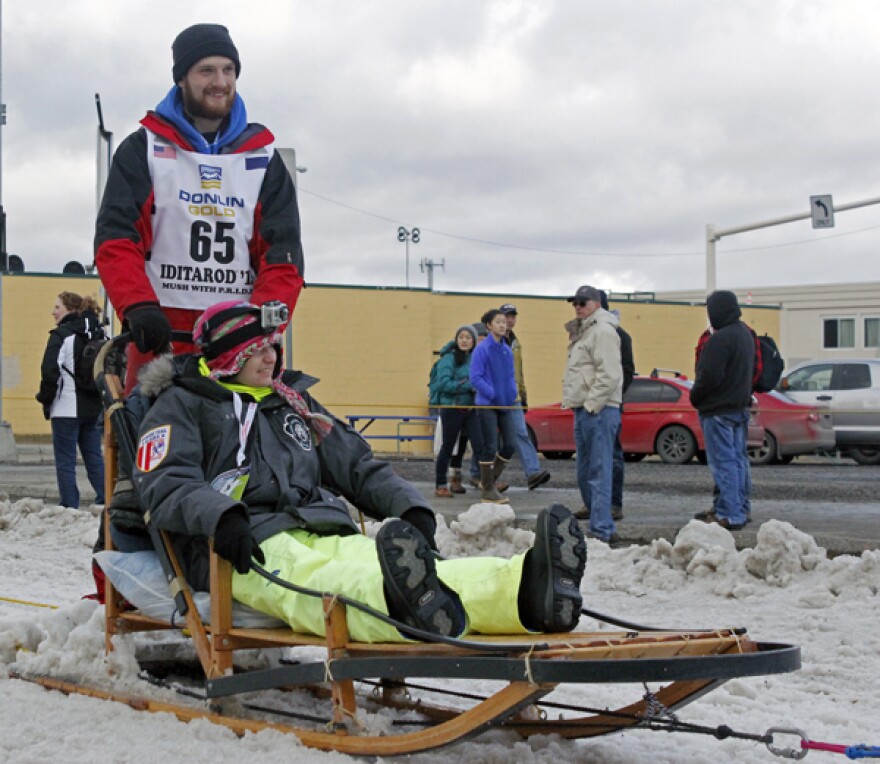For decades, a few big name mushers have dominated the standings in the Iditarod, but after decades of racing, many of them are reconsidering their priorities. Professional mushing may be in the midst of a “changing of the guard” as a small group of young mushers start to post top finishing times.
When Wade Marrs crossed the finish line of this year’s Iditarod, he was covered in sweat and panting. He was trying for the fastest run time between Safety and Nome.
“The dogs just looked really good and so we thought we’d do it for fun,” he said.
The Iditarod Trail Committee gives an award for the fastest time between the race’s final checkpoint and the finish line. As of Thursday evening, Marrs was still holding on to the honor, having beat Nicolas Petit by one second.
But in the future, the 24-year has loftier goals.
“Hopefully one day we’ll win this thing but for now we just keep improving, that’s our main goal,” he said.
Marrs is among a group of twenty-somethings who are starting to show off what their dog teams can do. This year’s champion Dallas Seavey is 27-years-old. He has been working for the last two years to build the kind of dogs that can win regardless of trail conditions, weather or musher error.
“This is kind of the beginning of that team. They’re very young,” Seavey said. “So this is the first team that pretty much everyone was born and raised in our kennel rather than the purchased dogs that we have been racing.”
He has posted top-five finishes the last five years in a row. But Seavey’s success can’t be credited solely to how he has raised his dogs. The animals he has purchased have come from champion kennels like Jeff King’s.
“I wrestled little Dallas Seavey when he was about nine years old and I’d pin him on the carpet and threatened to give him a noogie,” King said. “The Seavey boys took my girls to the prom.”
King has been racing dogs in the Iditarod for more than three decades. This year, he returned to try for a fifth championship, but mid-way through the race, he says he realized another win was unlikely.
“Once first wasn’t in reach realistically, for my energy or my dogs or the rate I wanted to go, I felt very comfortable just cooking along and my next goal might be to see how many times I can make the top-10 and then maybe another decade of top-20s – I don’t know.”
At 59-years-old, King is the oldest musher to finish among this year’s top-10. He’s not the only long-time musher that’s starting to realize just how hard it might be to keep up with competition that’s decades younger.
“I fall in the old school category now, sadly,” Aliy Zirkle said. She is 45-years-old and has run a team in every Iditarod for the last 15 years.
“I don’t have that twenty-some energy, I don’t have that twenty-some drive,” she said. “I have the, hopefully, the savvies and smarts of a 45-year-old woman and the twenty years of education that I can still stay in front of these young bucks, but I do not have the energy or the strength.”
Many mushers have talked about reevaluating their priorities this year. Like the two years previous, Martin Buser led the pack for the first half of the race, but in Huslia, he said he’d let his competitive nature get the best of him.
“The dog team can’t win,” he said. “I’ve made enough mistakes in this race so far, that I should just get to the finish line.”
At the back of the pack, his 25-year-old son is driving a team of puppies. But the older Buser wonders whether it’s a good idea for someone his son’s age to pursue a career in competitive mushing.
“If the new normal is glare ice bare ground, travelling 150 miles to run 50 miles by dog team and then drive home 150 miles by truck, if that’s the normal, he’s smart enough to see that – and he’s not the only competitive team in the up-and-coming ranks - is it really worth it spending 365, every penny, every hour, every bit of energy on just driving dogs?” Buser said.
But for guys like Wade Marrs, doing anything else probably isn’t an option.
“We definitely are going to be with it for quite a while, so it just depends,” Marrs said. “As long as we continue to do good and have fun with it, then we’ll keep doing it.”




